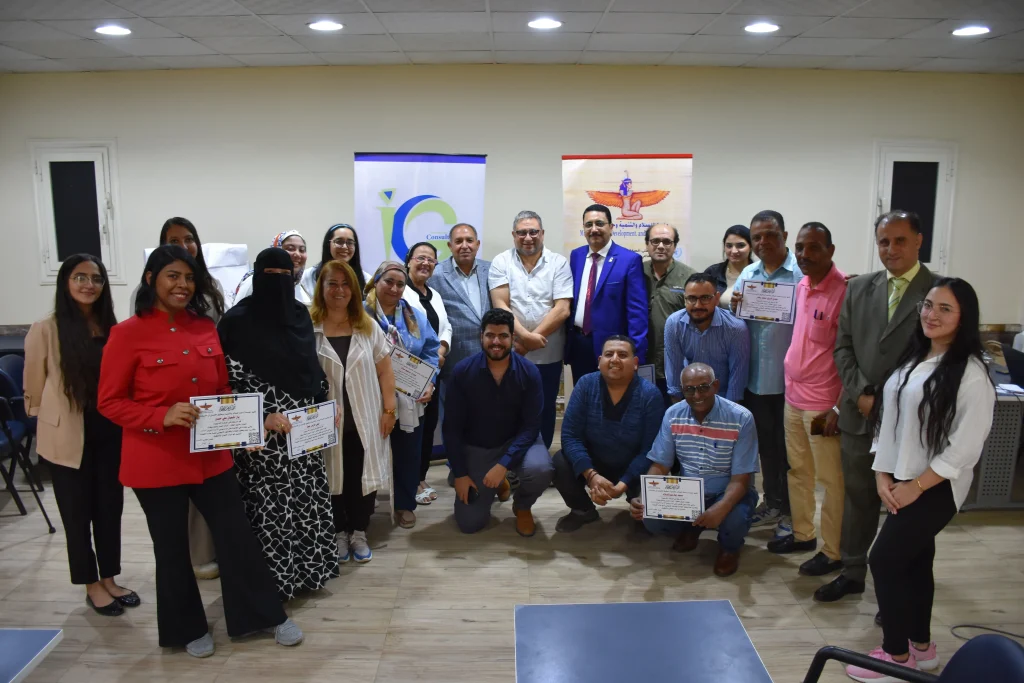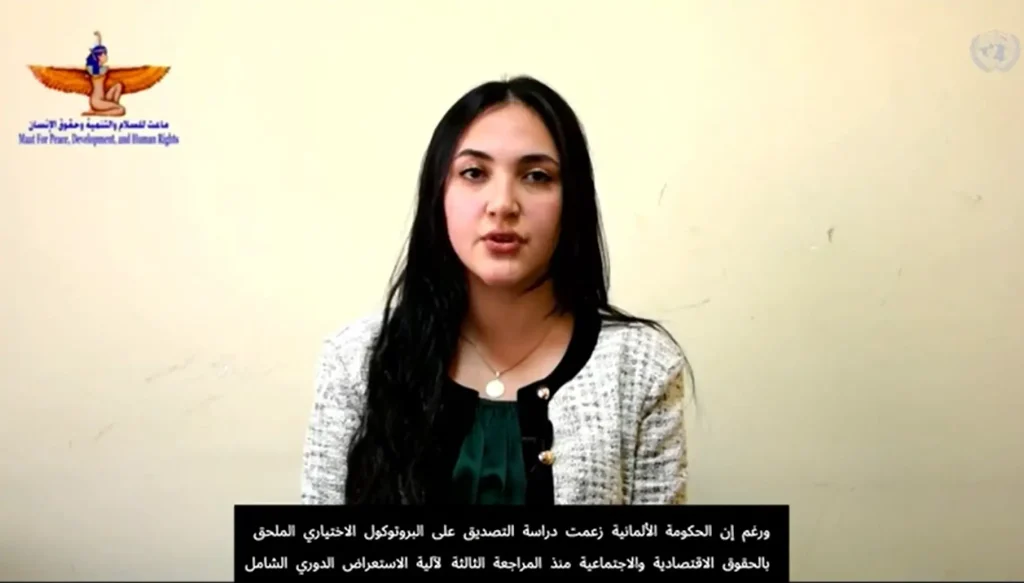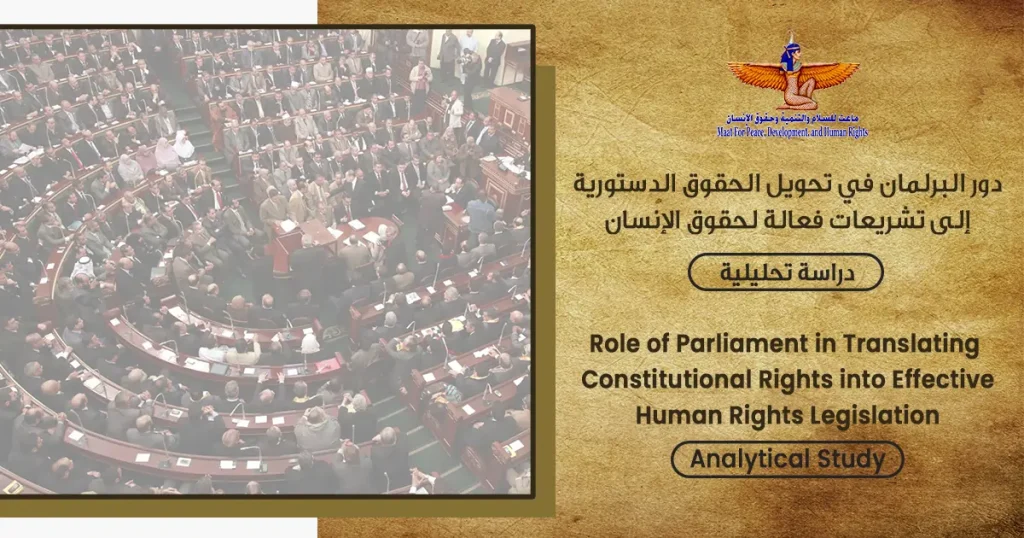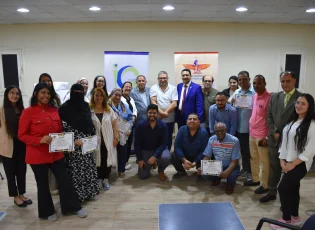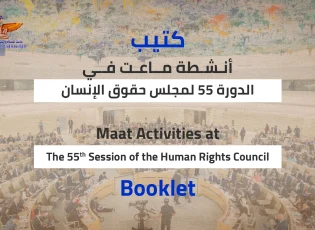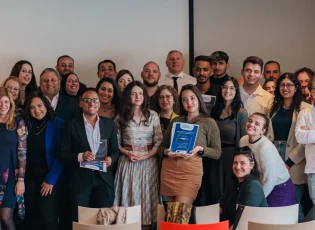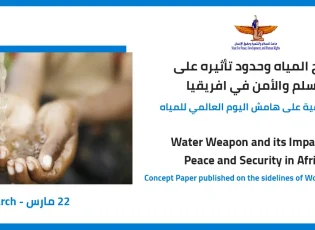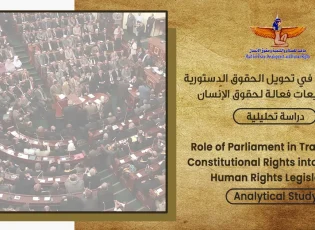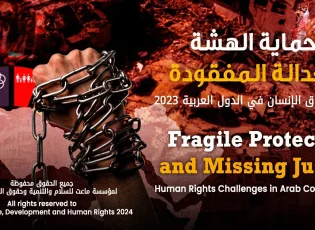A proposed vision
"To re-classify and arrange non-governmental work organizations in Egypt"
Policy Paper
Issued it
Public Policy Analysis and Human Rights Unit
Affiliate Foundation
, Maat for Peace, Development, and Human Rights
Under a project
“The Universal Periodic Review as a Tool to Improve Public Policies during the Transition” (funded by the European Union)
June 5, 2016
“This release was implemented with the help of the European Union. The content of this publication is the responsibility of the Maat Foundation for Peace, Development and Human Rights and can in no way be considered a reflection of the vision of the European Union.
Introduction:
Civil work institutions gain their importance from the role they play as an organizational framework that accommodates the participation of people in achieving development in its comprehensive sense, and thus helping the state to fulfill its development obligations, and given the multiplicity and complexity of development aspects, it is natural and logical that the interests of the fields of work and types of civil organizations should multiply and diverge.
Whereas there is a current trend to change the NGO law in Egypt in line with the essence and text of the Egyptian constitution on the one hand and international obligations on the other hand, the Public Policy Analysis Unit at Maat Foundation for Peace, Development and Human Rights has directed to issue a set of policy papers that address different aspects of civil work. In order to help the legislative institution to see best practices in amending the law.
This paper deals with the issue of classifying private business institutions in Egypt, and the need for the new law to include fair and appropriate rules for dealing with NGOs according to their specific weight, institutional capabilities and degree of growth.
The paper deals with several basic points: First come civil organizations in Egypt, in terms of the historical role, and the concept of civil work organizations in Egypt, in addition to an overview of the developments in the number of civil work institutions in Egypt. The paper also deals with the classification of private work institutions in Egypt in terms of the nature of the activity of civil work organizations, the size and capabilities of civil institutions, the law’s dealings with civil work organizations, and finally, the paper deals with the importance of classifying private work institutions in Egypt, and the proposed criteria for classification.
The first axis: civil organizations in Egypt:
First: A historical look at civil work in Egypt:
The beginnings of the emergence of civil societies in Egypt go back to the nineteenth century, when the first civil society was established in Egypt in 1821 in the name of the Greek Association in Alexandria, then the establishment of associations such as (the Egypt Society for Research on the History of Egyptian Civilization in 1859, the Society of Knowledge in 1868, and the Geographical Society) In 1875, the Islamic Charitable Society in 1878, and the Coptic Philanthropic Society in 1881), and at the beginning of the twentieth century, the NGO movement succeeded in establishing the first modern Egyptian university in 1912 under the name of Fouad I University, which is now Cairo University.
With the 1923 Constitution recognizing in its Article No. 20 the right of Egyptians to assemble and form associations, the number of civil societies increased dramatically, as their number increased from 159 civil societies between 1900 and 1924 to 633 civil societies in the period from 1925 to 1944.
The first law regulating the work of associations was issued in the forties of the last century (Law No. 49 of 1945), which provided for the registration of associations and placed them under the supervision of the Ministry of Social Affairs and its administrative systems and encouraged them to proceed with their social efforts, and after the July Revolution, Law No. 384 of 1956 was issued. In order to coordinate social services, it was stipulated to establish regional federations to organize work with associations and coordinate their services with each other, and after that, the Civil Associations Law No. 32 of 1964 was issued, which continued to work for a long time until the issuance of Law No. 153 of 1999, and in 2002 it was issued. Law 84 of 2002, which is the law currently governing the work of associations and civil institutions in Egypt.
With the issuance of Law No. 84 of 2002, the number of civil societies increased dramatically, and their role has grown over the past years. These NGOs were classified into several categories, including human rights organizations that work within a human rights framework, and others that work in the fields of development, social care and charitable activities. In addition to a number of civil societies, which are known as non-profit civil companies that carry out the work of civil societies and institutions.
Second: The concept of civil organizations and the statistics of civil organizations
Law No. 84 of 2002 deals in a different way with civil associations and institutions. According to Law No. 84 of 2002, a civil society is intended as “every group with a continuous organization for a certain or indefinite period consisting of natural persons, or legal persons, or both of them. Their number shall not be less than ten in all cases, for a purpose other than obtaining a material profit.
Although the law governing the work of civil organizations in Egypt is Law 84 of 2002, and the Ministry of Social Solidarity is based on its application, in few cases NGOs take the form of non-profit civil companies, and in this case they are not subject to the supervision of the Ministry of Social Solidarity. Time is not subject to the provisions of Law 84 of 2002, but it performs the same functions as other NGOs subject to these mechanisms.
In establishing the association, the law stipulates that it have a written statute signed by the founders, and that it have an appropriate headquarters for its management in the Arab Republic of Egypt. Also, it is not permissible to participate in the founding of the association against whom a final judgment has been issued for a felony penalty or for a freedom-restricting penalty for a misdemeanor violating honor or trust, unless he has been rehabilitated. Non-Egyptians may participate in the membership of the association according to the rules contained in the executive regulations of this law.
While Law No. 84 of 2002 stipulates that a civil institution is established to allocate money for a specific or indefinite period to achieve a purpose other than material profit, and the provisions of Article (11) of this law shall apply in this regard, and the establishment of a civil institution is by one founder or a group of The founders are natural persons or legal persons or both of them. The founders put in place a basic system that includes, in particular, data. The establishment of a civil institution could also be by one founder or a group of founders from natural persons or legal persons, or both.
The number of civil organizations has witnessed a significant increase during the past years, and despite the inconsistency in the statistics of civil organizations, government estimates indicate that there are more than 46 thousand associations and civil institutions, of which 93 foreign organizations work with permission, some of which are classified as human rights organizations. Some of them work in the fields of development, social care and charitable activities, in addition to a limited number of organizations that are known as non-profit civil companies that carry out the work of civil societies and institutions.
The second axis: classification of private business institutions in Egypt:
First: Classification according to the nature of the main activity:
According to Article 11 of Law 84 of 2002, the law requires NGOs to define specific fields for development work before they obtain legal notification, and according to the main fields of work and actual activity common to civil society organizations in Egypt, these organizations can be classified into several categories, as follows:
1- Charitable organizations: It includes all non-governmental organizations that work in the field of charitable work in its traditional form (social aid and direct aid). It also includes service and social care organizations: they are those that are active in many social fields and provide health services and various economic and social services such as children, women, the elderly and the family. And others, and these associations are the basic form of the work of Egyptian civil organizations, and examples of those charitable organizations (Resala Association, Misr El-Kheir Association ... etc.).
2- Development organizations: They are those organizations that are mainly concerned with development efforts in the community, and aim to achieve development within a specific local community framework (such as local community development societies spread in most villages), as they depend on mobilizing the community’s energies in order to establish facilities, and also depend on Building the capabilities of individuals to take advantage of development opportunities, and an example of these organizations is (Sawiris Foundation for Social Development).
3- Defense organizations: They are those organizations that are interested in defending public rights and freedoms, examples of which are human rights organizations, the defense of women and their rights, disability rights organizations, organizations defending the rights of homeless children, in addition to environmental protection organizations and consumer protection organizations, and from Examples of these organizations include: (Association for Freedom of Thought and Expression, Cairo Center for Human Rights, Arab Network for Human Rights Information, Egyptian Center for Economic and Social Studies, El Nadim Center for Rehabilitation of Victims of Violence and Torture, Egyptian Center for Women Rights, Nazra Center for Settlement Studies, Habi Center for Environmental Rights. , …… .. etc.).
Second: Classification according to size
Civil society institutions operating in Egypt can be classified in terms of size, whether in terms of institutional capacities or financing capacities, or with regard to the institution's ability to obtain membership in international and regional institutions:
In terms of institutional capabilities, private business institutions in Egypt differ in terms of institutional capabilities. There are some private institutions that do not have any institutional capabilities other than having only a small headquarters that allows them to practice activity within their local scope, as Law No. 84 of 2002 stipulated, according to Article 3 of the law, that the statute of the association must include the type, field, activity of the association, its geographical scope of work, and the address of the headquarters that is the center of the association’s management.
With regard to financing capabilities, the ability of civil work institutions to obtain different funding grants to practice their activities and their ability to carry out what their statutes have specified in terms of the association’s resources and the way to exploit and dispose of them varies according to Article 3 of Law No. 84 of 2002, where there are civil societies that can Obtaining enormous financial capabilities that enable them to perform their activities, and there are other civil societies that have simple financial capabilities that enable them to play a limited role within society, and other civil societies do not have any financial resources, and do not practice any activity within the community due to their inability to obtain financial resources For the association.
As for obtaining membership in international and regional institutions, the ability of NGOs operating in Egypt differs in terms of the ability to obtain membership in international or regional institutions. There are large civil organizations working in Egypt for long periods and in different fields of work. They were able to obtain membership in organizations. There are other institutions that do not have any ability to obtain membership in international and regional organizations, but they are content to work within the local scope in Egypt only, due to their weak institutional capacities.
Third: Classification of civil organizations according to legal dealings:
Egyptian law did not differentiate in dealing with associations or civil institutions operating in Egypt, whether in terms of legal or administrative dealings with different civil societies and institutions according to their classification, whether in terms of their activities or in terms of their financing and institutional capabilities, and they deal with them with the same administrative rules and procedures, and then all societies are subject to And civil institutions operating in Egypt for Law No. 84 of 2004. All associations and civil institutions operating in Egypt deal with the various administrative authorities stipulated in the executive regulations of Law No. 84 of 2002, such as the Ministry of Social Solidarity represented by the Minister, and the Central Administration for Associations and Unions. And the Directorate of Social Affairs, the Central Administration for Social Welfare or the Central Administration for Social Development, and therefore there is no difference in legal or administrative dealings with regard to the various associations and civil institutions operating in Egypt.
The third axis: the proposed vision for the classification of private work institutions
First: The importance of classifying private work institutions:
The new law must include a positive distinction in detailed (not general) legal transactions between civil organizations according to their institutional capabilities, degree of growth, and the nature of their presence on the regional and international arenas, and the importance of this comes from: -
1- Create an incentive for NGOs to grow and enhance their capabilities.
2- Benefiting from the efforts of large-scale non-governmental organizations with an influential regional and international presence to serve the objectives of the Egyptian state and meet its ambitions internally and externally.
3- Facilitating means of communication, supervision and control between civil organizations on the one hand and administrative bodies on the other hand.
4- Providing the opportunity for cooperation, exchange of experiences, and support from organizations in a higher classification to organizations in lower classifications.
5- Upgrading the value of specialization among NGOs, and at the same time opening the door for integration between organizations and each other.
Second: The proposed vision for the classification
It is suggested that NGOs be classified legally according to two criteria, the first criterion is the nature of the main activity, and the second is the organizational level, and the following is an explanation for each criterion: -
• Classification according to the main activity
1- Relief organizations: which mainly work in the field of providing direct aid to the poor and at-risk groups or those exposed to emergency disasters, such as the existing charitable organizations and social welfare organizations.
2- Supporting organizations: that work mainly in the field of building human and institutional capacities, in order to enable the beneficiaries of their activities to access various development opportunities, examples of which are organizations working in the field of training for employment, participation in providing public facilities and services, organizations working in the field of development Economic, Investors Associations, etc.
3- Defense organizations: which work mainly in the field of raising awareness of legal and constitutional rights, monitoring, documenting, confronting human rights violations, providing support to victims, following up on general elections, political awareness and promoting democracy.
4- Research organizations: which work mainly in the field of research and studies and provide alternatives to public policies, examples of which are think tanks.
5- Cultural organizations: that work in the field of promoting cultural diversity, preserving cultural heritage, and producing informational materials and cultural products for a non-profit purpose.
6- Social and religious service organizations: Examples include the service associations scattered in most bodies and interests, which provide a package of social, entertainment and religious services to their members, as well as associations working in the field of facilitating visits to holy sites (such as Hajj and Umrah)
• Classification according to the organizational level
It is suggested that a civil organization, regardless of its main activity, be classified into three categories. The presence of the organization in a certain category will result in legal treatment different from the other as follows: -
1- "A" classification organizations: they deal directly with a special department at the Ministry of Social Solidarity.
2- The “B” classification organizations: they deal directly with a special department of the concerned Social Solidarity Directorate.
3- Category “C” organizations: they deal directly with a special department in the concerned social solidarity department
The executive regulations of the law must specify the specific criteria that entail the existence of the organization in a specific classification, and it is suggested that the standards include the following: -
1- The organization's internal governance pattern.
2- The size of the annual budget
3- Obtaining a consultative status or membership in international and regional organizations.
4- Geographical spread of the organization’s activities.
5- Human capabilities
6- Organizational capabilities
7- Institutional equipment
8- Numbers of beneficiaries from the organization’s activities
9- Results and impact of the organization’s work




